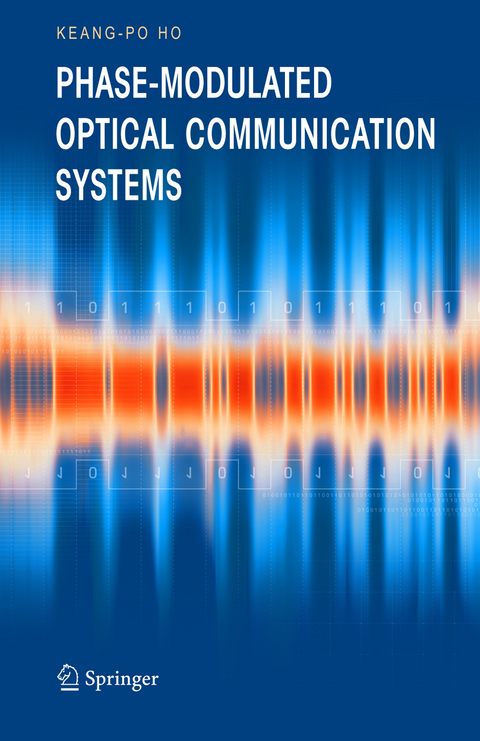
Phase-Modulated Optical Communication Systems
Seiten
2005
Springer-Verlag New York Inc.
978-0-387-24392-4 (ISBN)
Springer-Verlag New York Inc.
978-0-387-24392-4 (ISBN)
Covers topics such as: the transmitter and receiver for phase-modulated coherent lightwave systems; method for performance analysis of phase-modulated optical signals; and direct-detection DPSK signal with fiber nonlinearities, degraded by nonlinear phase noise effects. This work is useful for graduate students, engineers, and researchers.
Fiber-optic communication systems have revolutionized our telecommunication infrastructures – currently, almost all telephone land-line, cellular, and internet communications must travel via some form of optical fibers. In these transmission systems, neither the phase nor frequency of the optical signal carries information – only the intensity of the signal is used. To transmit more information in a single optical carrier, the phase of the optical carrier must be explored.
As a result, there is renewed interest in phase-modulated optical communications, mainly in direct-detection DPSK signals for long-haul optical communication systems. When optical amplifiers are used to maintain certain signal level among the fiber link, the system is limited by amplifier noises and fiber nonlinearities. Phase-Modulated Optical Communication Systems surveys this newly popular area, covering the following topics:
- The transmitter and receiver for phase-modulated coherent lightwave systems
- Method for performance analysis of phase-modulated optical signals
- Direct-detection DPSK signal with fiber nonlinearities, degraded by nonlinear phase noise and intrachannel effects
- Wavelength-division-multiplexed direct-detection DPSK signals
- Multi-level phase-modulated optical signals, such as the four-phase DQPSK signal.
Graduate students, professional engineers, and researchers will all benefit from this updated treatment of an important topic in the optical communications field.
Fiber-optic communication systems have revolutionized our telecommunication infrastructures – currently, almost all telephone land-line, cellular, and internet communications must travel via some form of optical fibers. In these transmission systems, neither the phase nor frequency of the optical signal carries information – only the intensity of the signal is used. To transmit more information in a single optical carrier, the phase of the optical carrier must be explored.
As a result, there is renewed interest in phase-modulated optical communications, mainly in direct-detection DPSK signals for long-haul optical communication systems. When optical amplifiers are used to maintain certain signal level among the fiber link, the system is limited by amplifier noises and fiber nonlinearities. Phase-Modulated Optical Communication Systems surveys this newly popular area, covering the following topics:
- The transmitter and receiver for phase-modulated coherent lightwave systems
- Method for performance analysis of phase-modulated optical signals
- Direct-detection DPSK signal with fiber nonlinearities, degraded by nonlinear phase noise and intrachannel effects
- Wavelength-division-multiplexed direct-detection DPSK signals
- Multi-level phase-modulated optical signals, such as the four-phase DQPSK signal.
Graduate students, professional engineers, and researchers will all benefit from this updated treatment of an important topic in the optical communications field.
Keang-Po Ho is currently with National Taiwan University. He was the cofounder and CTO of StrataLight Communications. His research interests are the system issues of high-speed optical communications, and he has authored more than 150 technical publications.
Digital Modulation of Optical Carrier.- Coherent Optical Receivers and Ideal Performance.- Impairment to Optical Signal.- Nonlinear Phase Noise.- Compensation of Nonlinear Phase Noise.- Intrachannel Pulse-to-Pulse Interaction.- Wavelength-Division-Multiplexed DPSK Signals.- Multilevel Signaling.- Phase-Modulated Soliton Signals.- Capacity of Optical Channels.
| Erscheint lt. Verlag | 1.7.2005 |
|---|---|
| Zusatzinfo | XVI, 430 p. |
| Verlagsort | New York, NY |
| Sprache | englisch |
| Maße | 155 x 235 mm |
| Themenwelt | Naturwissenschaften ► Physik / Astronomie ► Optik |
| Technik ► Elektrotechnik / Energietechnik | |
| Technik ► Nachrichtentechnik | |
| ISBN-10 | 0-387-24392-5 / 0387243925 |
| ISBN-13 | 978-0-387-24392-4 / 9780387243924 |
| Zustand | Neuware |
| Informationen gemäß Produktsicherheitsverordnung (GPSR) | |
| Haben Sie eine Frage zum Produkt? |
Mehr entdecken
aus dem Bereich
aus dem Bereich
Grundlagen - Verfahren - Anwendungen - Beispiele
Buch | Hardcover (2022)
Hanser, Carl (Verlag)
49,99 €
Aufgaben mit Lösungen
Buch | Hardcover (2023)
Hanser, Carl (Verlag)
29,99 €


